Secondary Battery Market Research, 2032
The global secondary battery market was valued at $96.7 billion in 2022, and is projected to reach $261.8 billion by 2032, growing at a CAGR of 9.8% from 2023 to 2032.
Key Report Highlighters:
- The report outlines the current secondary battery market trends and future scenario of the market from 2023 to 2032 to understand the prevailing opportunities and potential investment pockets.
- The global secondary battery market has been analyzed in terms of value ($ million). The analysis in the report is provided for 4 major regions and more than 15 countries.
- The secondary battery market is fragmented in nature with few players such as Panasonic Corporation, Amperex Technologies, BYD Company Ltd., and Hitachi, which hold significant share of the market.
- The report provides strategy planning and industry dynamics to enhance decision making for existing market players and new entrants entering the secondary battery market.
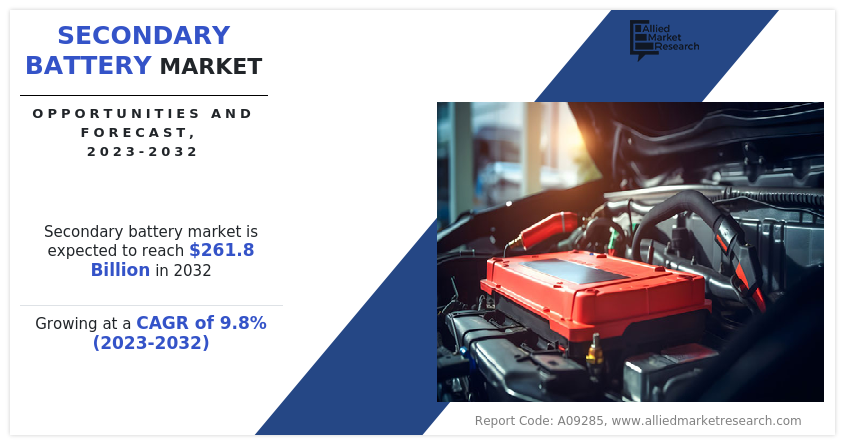
A secondary battery is a rechargeable battery which is also widely known as a storage battery. It is a kind of energy storage device which is majorly used to charge and discharge for multiple uses. These batteries are mainly designed so that they are reused for the purpose of providing a sustainable source of electrical energy. Since primary batteries or non-rechargeable batteries are designed for single use only and are discarded after being depleted it led to generation of large amounts of electronic waste (e-waste).
However, secondary batteries are largely preferred for their reusable property and help in reducing e-waste to a large extent. The main advantage of secondary batteries that drives the growth of the market is their rechargeability. Secondary batteries are plugged to a power source such as electrical outlets to provide power. In renewable energy system, it is used for connecting the power outlets which helps restore energy storage capacity. Secondary batteries are subject to numerous charge and discharge cycles. A battery's chemistry and design determine how many cycles it can withstand. The market offers a variety of secondary battery types with varied chemistries.
Common materials used in construction of secondary batteries are lead-acid, lithium-ion (Li-ion), nickel-cadmium (NiCd), nickel-metal hydride (NiMH), and nickel-cadmium (NiCd). The various battery chemistries used determine different benefits, such as energy density, voltage, and lifespan. Secondary batteries are used in a wide range of things, from laptops and smartphones to electric cars, backup power systems, and renewable energy storage. Secondary batteries are available in the market in different energy densities, that is depending on space available for storage, different variants are used as per requirement.
Lithium-ion batteries have high energy density and thus are very suitable for use in electric cars and other portable gadgets. Secondary batteries are cost-efficient for use in the long term. Although they have a higher investment and upfront cost, this acts as a market restraint for the secondary battery market growth. However, when compared to disposable primary batteries, secondary batteries can be recharged and reused which significantly reduces the total cost of ownership.
Because they may be reused numerous times, secondary batteries are more environmentally friendly than primary batteries. By doing this, less battery waste is dumped in landfills, reducing environmental damage. Secondary batteries are essential for advancing sustainability, particularly in uses like electric vehicles and the storage of renewable energy. They lessen reliance on fossil fuels and enable the effective utilization of renewable energy sources. Rechargeable batteries are practical and lessen the frequency of battery replacements. For several portable electronics like computers, smartphones, and digital cameras, secondary batteries are a significantly suitable choice owing to the above-mentioned benefits. For instance, lithium-ion batteries can store a lot of energy in a relatively tiny and light packaging due to their high energy density.
Small electronics to grid-scale energy storage systems are just a few of the many applications for secondary batteries that are flexible and suitable. They are available in many chemistry and size configurations. Many secondary batteries have a long cycle life, which means they can withstand hundreds or even thousands of charge-discharge cycles before suffering a substantial loss in capacity. This extends their useful lifespan. Despite having long cycle lives, secondary batteries do eventually degrade over time, leading to reduced capacity. This is a challenge, especially in applications where consistent performance is critical. The production of some secondary battery chemistries, such as lithium-ion batteries, involves the extraction and processing of raw materials that can have environmental impacts.
Recycling and responsible disposal of batteries are essential to mitigate these effects. Some secondary battery chemistries can pose safety risks if not handled properly. Overcharging, thermal runaway, and potential fire hazards are safety challenges that have been associated with certain types of batteries. The increasing demand for energy storage solutions, including grid-scale energy storage and residential energy storage systems, presents significant opportunities for secondary batteries. The growth of the electric vehicle market offers a vast opportunity for secondary batteries.
High-energy-density batteries with fast charging capabilities are in demand for EV applications. To save the extra energy created by sources like solar panels and wind turbines for later use, we need regular batteries. These batteries make renewable energy systems more reliable. Scientists are always working to make these batteries work better, be safer, and cost less. So, there's still a lot of room for new and better types of batteries. Increasing environmental awareness and regulations regarding battery disposal and recycling are driving the development of more sustainable secondary battery technologies.
Market Dynamics
Secondary batteries are vital for grid-scale energy storage and residential energy storage systems. These solutions enhance grid stability, support peak load management, and enable the efficient use of electricity. As a means of lowering carbon emissions and advancing clean energy, secondary batteries are becoming more and more in demand due to rising environmental consciousness and the need for sustainable energy solutions.
The mining and processing of raw materials that may have a negative environmental impact are necessary for the manufacture of secondary batteries, notably lithium-ion batteries. Responsible disposal and recycling are crucial to mitigate these effects. The initial cost of some advanced secondary batteries, such as those with high energy density, can be a barrier to adoption in certain applications. Reducing production costs is an ongoing challenge.
The expansion of the electric vehicle market offers substantial growth opportunities. Secondary batteries with high energy density and fast charging capabilities are in demand for EV applications. Opportunities for innovation in secondary battery technologies are created by ongoing research and development projects aimed at improving battery performance, safety, and cost-effectiveness. Manufacturers of secondary batteries have the opportunity to create cutting-edge, high-capacity battery solutions because there is a constant desire for new and better consumer electronics.
The secondary battery market scope is analyzed on the basis of type, application, industry vertical, and region.
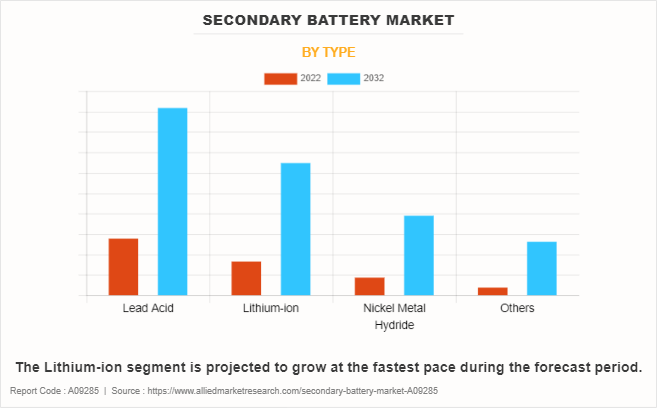
By type, the secondary battery market is divided into lead acid, lithium-ion, nickel metal hydride, and others. The lead acid battery segment dominated the secondary battery market share in 2022. The lead acid battery is widely used in many electronic devices and housing appliances which led to the secondary battery market growth. In the coming years, the use of lithium-ion batteries is expected to grow the fastest in the secondary battery market. This is because they are being used more and more in things like cell phones, home gadgets, and electric cars.
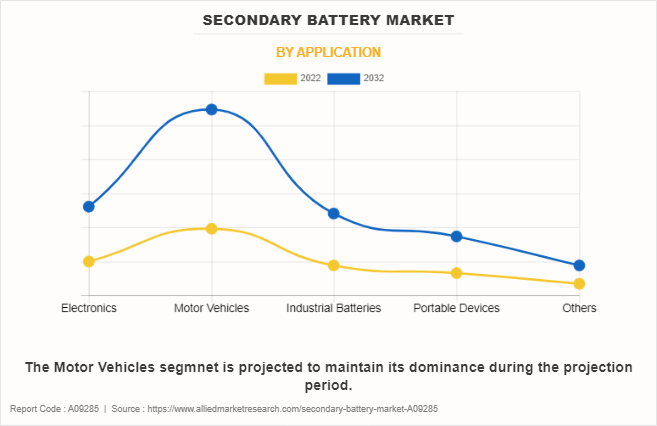
Based on the application, the market is divided into electronics, motor vehicles, industrial batteries, portable devices, and others. The motor vehicles segment dominated the secondary battery market share in 2022 and is further projected to continue to dominate the market during the projection years. This is owing to the large demand for the battery in electric vehicles boosted by the growing electrification of automotive industry.
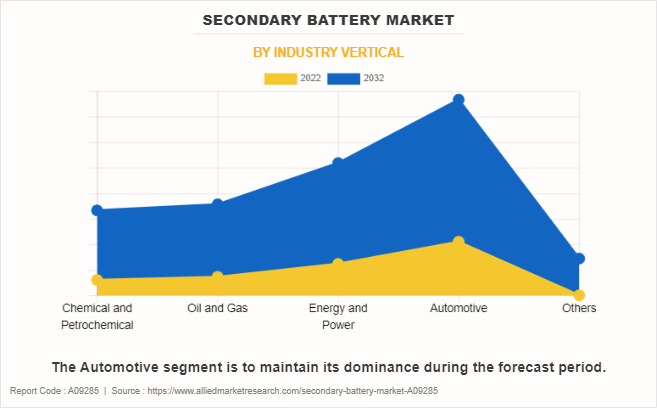
As per industry vertical, the secondary battery market size is categorized into chemical & petrochemical, oil & gas, energy & power, automotive, and others. The automotive segment dominated the market for 2022 and is expected to maintain its dominance throughout the secondary battery market forecast period.
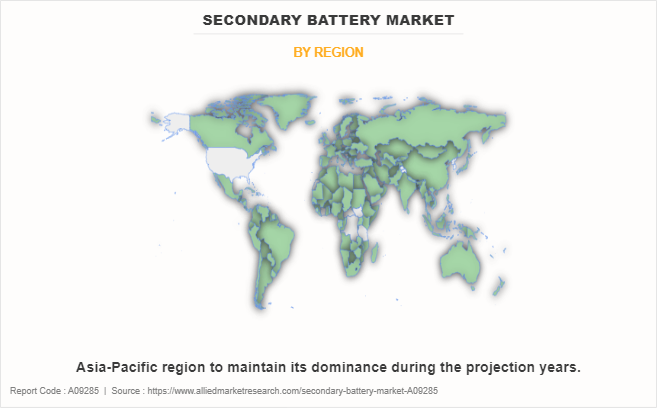
Region wise, the secondary battery market analysis is done across North America, Europe, Asia-Pacific, and LAMEA (Latin America, the Middle East, and Africa). Asia-Pacific is projected to grow at the highest CAGR during the analysis period and is also largest revenue contributor in 2022.
The major players operating in the secondary battery industry are Energizer Holdings Inc., LG Chem, BTI, Johnson Controls, Samsung SDI Co., Ltd., Aquion Energy, LLC, Panasonic Corporation, Amperex Technologies, BYD Company Ltd., and Hitachi High-Tech India Private Limited. The companies adopted key strategies such as collaboration to increase their market share.
Public Policies
- Safety Standards: Governments often establish safety regulations and standards for secondary batteries, particularly in applications like consumer electronics and electric vehicles. These standards cover aspects such as cell design, thermal management, and safety features to prevent issues like thermal runaway.
- Transportation Regulations: Regulations govern the transportation of secondary batteries, especially in the context of shipping and air travel. These regulations ensure safe handling and packaging to prevent accidents during transportation.
- Environmental Regulations: Secondary batteries can contain hazardous materials, such as lithium and cadmium. Environmental regulations dictate how these materials should be handled, recycled, or disposed of to minimize environmental impact.
- Energy Efficiency Standards: Some regions have energy efficiency standards for battery chargers and devices using secondary batteries. These standards aim to reduce energy consumption and promote the use of energy-efficient charging technologies.
- Quality Assurance Rules: Manufacturers often adhere to quality assurance rules to ensure that their secondary batteries meet specific performance and safety standards. These rules may include quality control processes and testing protocols.
- End-of-Life Rules: Rules and guidelines may specify how end-of-life secondary batteries should be managed. This includes rules for recycling, disposal, or repurposing of old batteries to reduce waste.
- Labeling and Marking Rules: Secondary batteries are often subject to labeling and marking rules to provide consumers and users with essential information, such as voltage, capacity, and safety warnings.
- International Standards: Organizations like the International Electrotechnical Commission (IEC) and the International Organization for Standardization (ISO) develop international standards for secondary batteries. These standards cover aspects such as safety, performance, and environmental impact.
- National Standards: Many countries have their own national standards for secondary batteries, often based on international standards. These standards ensure that batteries meet specific requirements for safety and quality.
- Industry Standards: Various industries, including the automotive and consumer electronics sectors, often establish industry-specific standards for secondary batteries. These standards may address unique performance and safety requirements for specific applications.
- Safety Standards: Safety standards, such as those related to thermal runaway prevention, overcharge protection, and short-circuit protection, are crucial in the secondary battery industry to ensure safe use and prevent accidents.
- Performance Standards: Performance standards define the expected performance characteristics of secondary batteries, including parameters like capacity, voltage, cycle life, and energy efficiency.
International standards
- ISO 12405: This standard specifies test methods and requirements for the electrical performance of lithium-ion secondary cells and batteries used in portable electronic devices. It covers parameters such as capacity, energy density, and electrical endurance.
- ISO 12405-1: Part 1 of ISO 12405 specifically addresses test methods for lithium-ion batteries intended for portable applications. It includes test procedures for capacity measurement, discharge characteristics, and cycle life testing.
- ISO 13674-1: This standard provides guidelines for the safe operation and use of lithium-ion batteries in portable applications. It covers aspects like handling, storage, and disposal of lithium-ion secondary cells and batteries.
- IEC 62133: Although not an ISO standard, IEC 62133 is a widely recognized international standard that defines safety requirements for secondary lithium cells and batteries. It includes various tests related to mechanical, electrical, and environmental aspects to ensure the safe use of lithium-ion batteries.
- ISO 19981: This standard outlines terms and definitions related to electrochemical energy storage systems, including secondary batteries. It provides a standardized terminology for discussing battery-related concepts and technologies.
- ISO 15848: While not battery-specific, ISO 15848 defines testing procedures for the assessment of the performance of industrial valves, including those used in the oil and gas industry. Proper valve operation is essential for the safety of battery systems in industrial applications.
- IEC 61436: This standard provides guidelines for the installation of secondary batteries in stationary applications, such as uninterruptible power supply (UPS) systems. It covers installation requirements, safety considerations, and maintenance practices.
- IEC 61427: This standard focuses on the design and maintenance of secondary batteries used in photovoltaic (solar) energy systems. It provides recommendations for battery selection, installation, and operation in renewable energy applications.
- ISO 16111: ISO 16111 specifies requirements and test methods for the evaluation of lead-acid batteries used in renewable energy systems, including off-grid solar and wind installations.
- IEC 62619: This standard covers safety and performance requirements for secondary lithium-ion batteries used in industrial applications. It includes guidelines for testing and evaluating the safety of these batteries.
Key Benefits For Stakeholders
- This report provides a quantitative analysis of the market segments, current trends, estimations, and dynamics of the secondary battery market analysis from 2022 to 2032 to identify the prevailing secondary battery market opportunities.
- The market research is offered along with information related to key drivers, restraints, and opportunities.
- Porter's five forces analysis highlights the potency of buyers and suppliers to enable stakeholders make profit-oriented business decisions and strengthen their supplier-buyer network.
- In-depth analysis of the secondary battery market segmentation assists to determine the prevailing market opportunities.
- Major countries in each region are mapped according to their revenue contribution to the global market.
- Market player positioning facilitates benchmarking and provides a clear understanding of the present position of the market players.
- The report includes the analysis of the regional as well as global secondary battery market trends, key players, market segments, application areas, and market growth strategies.
Secondary Battery Market Report Highlights
| Aspects | Details |
| Market Size By 2032 | USD 261.8 billion |
| Growth Rate | CAGR of 9.8% |
| Forecast period | 2022 - 2032 |
| Report Pages | 282 |
| By Type |
|
| By Application |
|
| By Industry Vertical |
|
| By Region |
|
| Key Market Players | Amperex Technologies, Energizer Holdings Inc., Panasonic Corporation, LG Chem, BTI, Aquion Energy LLC, BYD Company Ltd., SAMSUNG SDI CO., LTD., Hitachi High-Tech India Private Limited, Johnson Controls |
Analyst Review
According to the insights from the CXO’s, secondary batteries are essential components of modern technology and sustainability efforts, offering cost-efficiency, environmental benefits, and versatility. The secondary battery market is driven by the growth of electric vehicles, renewable energy integration, consumer electronics, and advancements in technology. However, they also face challenges that require ongoing research and development to address. Moreover, it faces challenges related to limited lifespan, safety concerns, environmental impact, and production costs. Opportunities lie in energy storage solutions, electric vehicles, renewable energy integration, research-driven innovation, and sustainability initiatives
$261.8 Billion is the estimated industry size of Secondary Battery by 2032,
Energy storage solutions and environmental awareness, rising demand for electric vehicles (EVs) and renewable energy integrity, consumer electronics and advancements in battery technology are the upcoming trends of Secondary Battery Market in the world.
Automotive is the leading application of Secondary Battery Market.
Asia-Pacific is the largest regional market for Secondary Battery.
Energizer Holdings Inc., LG Chem, BTI, Johnson Controls, Samsung SDI Co., Ltd., Aquion Energy, LLC, Panasonic Corporation, Amperex Technologies, BYD Company Ltd., and Hitachi are the top companies to hold the market share in Secondary Battery.
Loading Table Of Content...
Loading Research Methodology...



